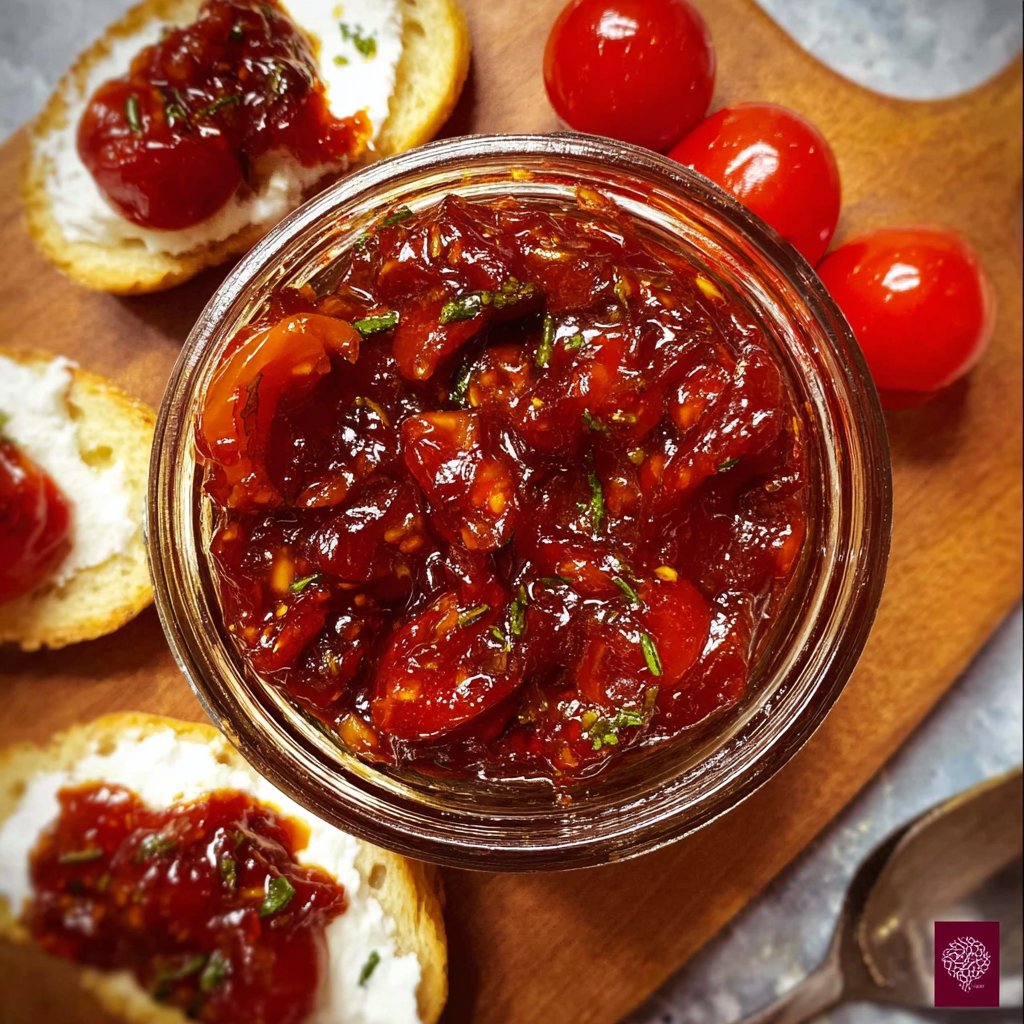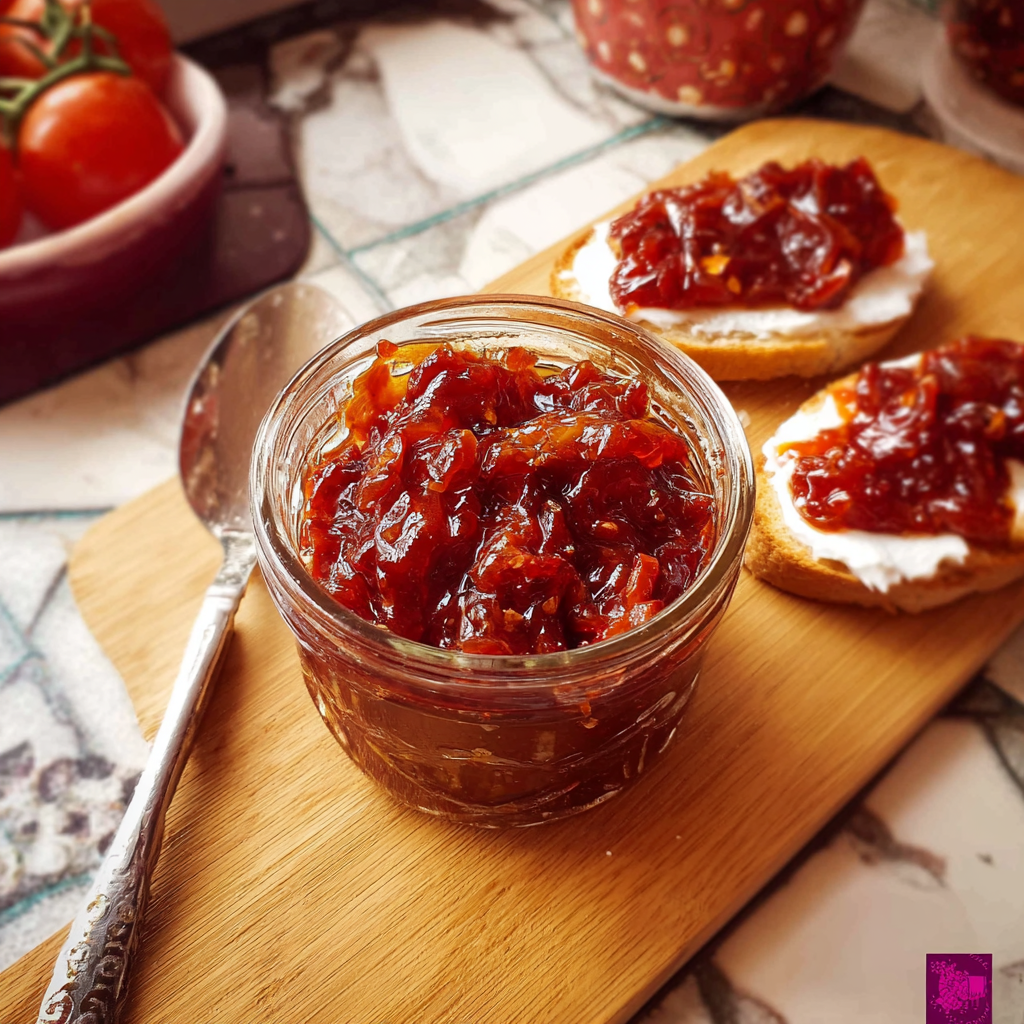Introduction
Tomato jam is one of those old-fashioned recipes making a modern comeback. Imagine the perfect marriage of ripe summer tomatoes, natural sweetness, a touch of acidity, and savory spices. The result is a sweet-savory condiment that works on toast, with cheese, or even as a burger topping.
This guide covers everything you need to know: what tomato jam is, how to make it, canning vs. refrigerator storage, variations, and troubleshooting. For safe canning techniques, many home preservers follow the NCHFP Spiced Tomato Jam & canning guidance.
Before diving into the recipe, let’s understand what makes tomato jam so special and why it has a place in your pantry. For a trusted step-by-step method, see Ball Mason Jars canning steps for tomato jam.
What is Tomato Jam?
Tomato jam is a preserve made from fresh tomatoes cooked slowly with sugar, vinegar or lemon juice, and spices until thickened. Unlike ketchup, it is chunkier and more concentrated in flavor. Compared to chutney, tomato jam is sweeter and less vinegar-heavy.
Think of it as ketchup’s more complex cousin—spreadable, tangy, and versatile.
Short History & Global Variations
Recipes for tomato jam appear in 19th-century American cookbooks, often spiced with ginger, cinnamon, and cloves. In South Africa, it is a beloved preserve served with bread. Modern chefs experiment with spicy jalapeño tomato jam, bacon-tomato jam, or herb-infused versions.
Flavor Profile & Common Uses
The flavor layers of tomato jam are what make it irresistible:
- Umami depth from slow-cooked tomatoes
- Sweetness balanced by vinegar or citrus
- Warm spice notes (cinnamon, ginger, chili)
- Optional smoky or savory add-ins (like bacon)
Ways to enjoy tomato jam:
- Spread on toast with goat cheese
- Use as a burger topping
- Pair with roasted meats as a glaze
- Add to a charcuterie board
- Stir into salad dressings for depth
Choosing Tomatoes
The choice of tomato impacts the texture and cooking time:
- Paste tomatoes (Roma, San Marzano): less watery, perfect for thicker jam.
- Cherry or Sungold tomatoes: naturally sweet, ideal for refrigerator or freezer jams.
- Heirlooms: great flavor complexity but may need longer cooking due to higher water content.
- Canned tomatoes: possible, but fresh delivers better set and brightness.
Ingredients & Why They Matter
- Tomatoes – the star; paste types concentrate best.
- Sugar – balances acidity, preserves texture.
- Acid (vinegar or bottled lemon juice) – essential for safe preservation.
- Salt – enhances flavor.
- Spices (ginger, cinnamon, chili, cloves) – add warmth and depth.
- Pectin (optional) – useful for low-sugar versions or quicker set.
For canning safety, always follow University extension canning safety for tomatoes.
Equipment & Prep
You’ll need:
- Large heavy pot
- Wooden spoon
- Funnel, jars, lids, and rings
- Water-bath canner or large pot
- Thermometer (optional)
Prep tips: Wash, core, and optionally peel tomatoes. Sterilize jars if canning.

Step-by-Step Small-Batch Tomato Jam Recipe
Yield: ~3 half-pint jars
Prep time: 20 minutes
Cook time: 1 hour
Ingredients:
- 3 lbs fresh Roma tomatoes (peeled & chopped)
- 1 ½ cups sugar (white or brown)
- ¼ cup bottled lemon juice
- 1 tsp grated ginger
- ½ tsp red pepper flakes
- ½ tsp cinnamon
- ½ tsp salt
Method:
- Combine tomatoes, sugar, lemon juice, and spices in a large pot.
- Bring to a boil, then reduce heat to simmer. Stir often.
- Cook 45–60 minutes until thickened. Test by placing a spoonful on a plate—if it gels and doesn’t run, it’s ready.
- Mash for smoother texture or leave chunky.
- Transfer to jars. For refrigerator storage, let cool and refrigerate. For canning, process in a boiling water bath (10 minutes, adjusting for altitude).
Canning vs Refrigerator vs Freezer
- Refrigerator jam: Lasts 2–8 weeks, depending on sugar and acid levels.
- Freezer jam: Safe up to 6 months; best for low-sugar versions.
- Canned jam: Shelf-stable for 1 year if properly acidified and processed.
⚠️ Tomatoes are borderline low-acid, so bottled lemon juice or citric acid is required for safe canning.
Troubleshooting Tomato Jam
- Runny jam: Simmer longer or use pectin.
- Too sweet: Add vinegar or lemon juice.
- Too acidic: Add sugar or cook longer.
- Burning: Lower heat and stir often.
Storage, Shelf Life & Safety
- Refrigerated jars: 2–8 weeks.
- Freezer jars: 6 months.
- Canned jars: Up to 12 months.
Always check lids for a seal. Discard jars with bulging lids, leaks, or odd smells.
Serving Ideas & Mini-Recipes
- Spread tomato jam on crostini with ricotta
- Glaze for roast chicken or pork
- Layer in a grilled cheese sandwich
- Dollop over baked brie
Mini recipe idea: Mix 2 tbsp tomato jam with 1 tbsp olive oil and 1 tsp balsamic vinegar for an instant salad dressing.
Variations
- Spicy jalapeño tomato jam
- Bacon-tomato jam
- Tomato-basil jam
- Ginger-orange tomato jam
- Low-sugar freezer tomato jam
FAQs
Can you can tomato jam?
Yes, but only with a tested recipe and acidification for safety.
How long does tomato jam last?
Fridge: 2–8 weeks; Freezer: ~6 months; Canned: 1 year.
What tomatoes are best?
Roma, San Marzano, or paste varieties for thick texture; cherry tomatoes for sweeter results.
Do I need pectin?
Not usually—tomatoes contain natural pectin. Use it for low-sugar versions.
Is tomato jam safe to can?
Yes, if you add bottled lemon juice/citric acid and follow water-bath canning guidelines.
Conclusion
Tomato jam combines summer’s best flavors into a spread that is versatile, sweet, savory, and satisfying. Whether you store it in the fridge, freezer, or pantry, it’s a condiment worth making. Try a small batch, enjoy it with cheese or meats, and experiment with creative variations.
